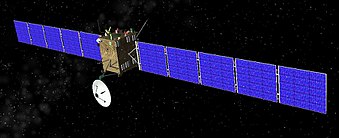Rosetta (spacecraft)
Rosetta is an ESA space probe. It is on a mission to study the comet 67P/Churyumov–Gerasimenko. The Rosetta mission is made up of two parts: the Rosetta space probe and the Philae lander. The spacecraft was launched on 2 March 2004 by an Ariane 5 rocket.
| Rosetta | |
|---|---|
 | |
| Organization: | European Space Agency |
| Major contractors: | European Space Agency |
| Mission type: | Comet Orbiter/Lander |
| Flyby of: | Earth, Mars, 2867 Šteins, 21 Lutetia |
| Satellite of: | 67P/Churyumov–Gerasimenko |
| Launch date: | 2 March 2004 |
| Launch vehicle: | Ariane 5G+ |
| Decay: | N/A |
| Mission duration: | 19 years, 8 months and 12 days elapsed |
| NSSDC ID: | 2004-006A |
| Webpage: | ESA-Rosetta |
| edit | |
Along with Philae, its lander module, Rosetta performed a detailed study of comet 67P/Churyumov–Gerasimenko (67P). During its journey to the comet, the spacecraft flew by Mars and the asteroids 21 Lutetia and 2867 Šteins.
On 6 August 2014, the spacecraft reached the comet and performed a series of moves to be captured in its orbit. On 12 November, its lander module Philae performed the first successful landing on a comet. However, its battery power ran out two days later.
Communications with Philae were briefly restored in June and July 2015, but due to diminishing solar power, Rosetta's communications module with the lander was turned off on 27 July 2016. On 30 September 2016, the Rosetta spacecraft ended its mission by landing on the comet in its Ma'at region.
The probe is named after the Rosetta Stone, of Egyptian origin, featuring a decree in three scripts. The lander is named after the Philae obelisk, which bears a bilingual Greek and Egyptian hieroglyphic inscription.